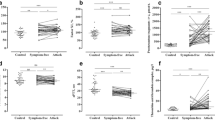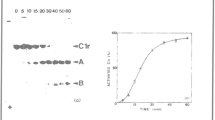Summary
C1-inactivator (C1-INA) does not only exert its important inhibitory functions in the complement system but also in the first step in the activation of the coagulation, fibrinolytic and kallikrein system. We therefore determined in nine patients with hereditary angioneurotic oedema (HANE) with obvious quantitative or functional defects of C1-INA, and one further patient with Quincke-type oedema of different origin, the coagulation factors of the initial phase such as Hageman factor, plasma thromboplastin antecedent (PTA) and high molecular weight kininogen (HMWK). These factors were further correlated with the concentration as well as functional activity of C1-INA. Ninc of ten patients showed a significant, sometimes even excessive, increase in the levels of factor XII (mean±SD=146%±63), HMWK (mean±SD=126%±56) and PTA (mean±SD=289%±294), and a decrease of C1-esterase inhibitor (C1-inactivator), which was measured with a immunologic method (mean±SD=9.6 mg/dl±6.6) for its concentration as well as being measured for its activity (mean±SD=30.4%±24.9).
Similar content being viewed by others
References
Böckers M, Bork K (1983) Hereditäres angioneurotisches Ödem: Klinische und serologische Befunde während Schwangerschaft und Wochenbett. Hautarzt (in press)
Bork K, Witzke G (1979) Hereditäres angioneurotisches Ödem. Klinik sowie erweiterte diagnostische und therapeutische Möglichkeiten. Dtsch Med Woschenschr 104:405
Donhoeffner A, Elert O (1981) Nephclometrische Untersuchungen über das hämostatische Gleichgewicht beim extrakorporalen Kreislauf. In: Breddin K (ed) Thrombose und Atherogenese. Witzrock, Baden-Baden Cologne New York, p 99
Frank MM, Gelfand JA, Atkinson JP (1976) Hereditary angioedema. The clinical syndrome and its management. Ann Intern Med 84:580
Gadek JE, Hosea SW, Gelfand JA, Santaella M, Wickerhauser M, Triantaphyllopoulos DC, Frank MM (1980) Replacement Therapy In Hereditary Angioedema. N Engl J Med 302:542
Gelfand JA, Sherins RJ, Alling DW, Frank MM (1976) Treatment of hereditary angioedema with danazol. N Engl J Med 295:1444
Heidemann D, Bork K (1979) Lebensbedrohlichc Larynxoedeme durch geringfügige zahnärztliche Eingriffe beim hereditären angioneurotischen Oedeme. Dtsch Zahnaerztl Z 34:430
Heimburger N (1975) Proteinase Inhibitors of Human Plasma, Their Properties and Control Functions. In: Reich E, Rifkin DB, Shaw E (eds) Proteases and Biological Control. Cold Spring Habor Laboratory, pp 367
Karges HE, Naumann H, Heimburger N (1982) HMW-Kininogen-Mangelplasma: Herstellung und diagnostische Bedeutung. In: Van de Loo J, Asbeck F (eds) Hämostasc, Thrombophilie und Arteriosklerose. Schattauer, Stuttgart New York, pp 690
Landermann NS (1962) Hereditary angioneurotic edema. J Allergy 33:316
Lottspeich F, Henschen A, Dittmann B, Müller-Esterl W (1981) Aminosäuresequenz von humanem hochmolekularem Kininogen im Bereich der Kallikreinspaltstellen. In: Blümel G, Haas S (eds) Mikrozirkulation and Prostaglandinstoffwechsel. Schattauer, Stuttgart New York, pp 161
Marasini B, Cicardi M, Martignoni GC, Agostini A (1978) Treatment of hereditary angioedema. Klin Wochenschr 56:819
Philapitsch A, Popov-Cenic S (1981) Pilotuntersuchungen von Inhibitoren, Inhibitionswirkungen und Aktivierbarkeiten im Plasma während der Herz-Lungen-Maschine. In: Blümel G, Haas S (eds) Mikrozirkulation und Prostaglandinstoffwechsel. Schattauer, Stuttgart New York, pp 221
Ratnoff OD (1979) Physiologie der Blutgerinnung. Behring Int Mitt 63:164
Schindera F, Rother U, Hufnagel C (1978) Hereditäres angioneurotisches Ödem. Helv Paediatr Acta 33:259
Schramm W, Penker W (1981) C1-Inaktivator bei thrombophilen Diathesen. In: Blümel G, Haas S (eds) Mikrozirkulation und Prostaglandinstoffwechsel. Schattauer, Stuttgart New York, pp 157
Steinbuch M (1980) Inhibitoren der Fibrinolyse. In: Deutsch E, Lechner K (eds) Fibrinolyse, Thrombose, Hämostase. Schattauer, Stuttgart New York, pp 23
Witzke G (1981) Das hämostatische Gleichgewicht: Gerinnung, Fibrinolyse und Inhibitoren. Lab Med 5:191
Witzke G, Elert O (1981) Beeinflussung des Hämostasegleichgewichtes durch den extrakorporalen Kreislauf (ECC). Anaesthesist 80:64
Author information
Authors and Affiliations
Rights and permissions
About this article
Cite this article
Witzke, G., Bork, K., Benes, P. et al. Hereditary angioneurotic oedema and blood-coagulation: Interaction between C1-esterase-inhibitor and the activation factors of the proteolytic enzyme systems. Klin Wochenschr 61, 1131–1135 (1983). https://doi.org/10.1007/BF01530840
Received:
Revised:
Accepted:
Issue Date:
DOI: https://doi.org/10.1007/BF01530840




